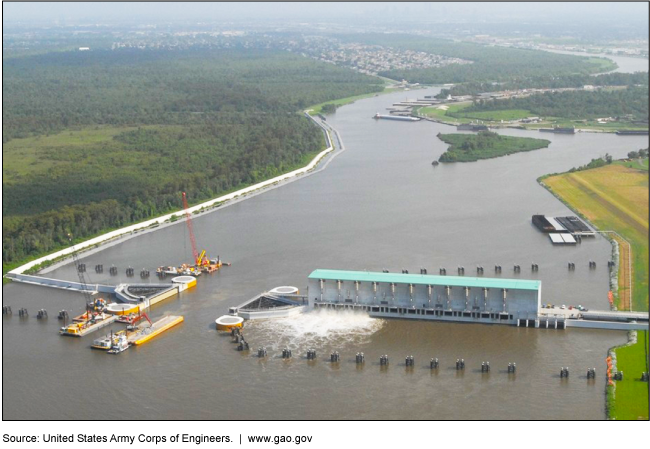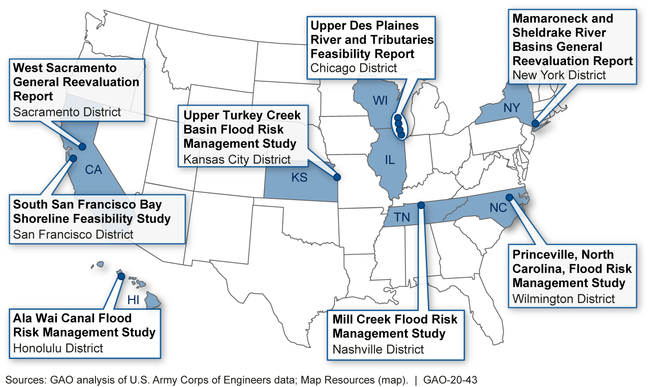Army Corps of Engineers: Evaluations of Flood Risk Management Projects Could Benefit from Increased Transparency
Fast Facts
The U.S. Army Corps of Engineers studies the potential costs and benefits of flood risk management projects—such as levees, floodwalls, or building relocation—to inform decision makers about their potential economic effects.
We reviewed 8 Corps studies and found they followed many best practices. But the analyses were not always transparent. For example, only one study considered the limitations of the computer model used in a flood damage analysis. Without that information, reviewers can’t make the best decisions on which projects would be most beneficial.
We recommended the Corps strengthen its internal review process to ensure decision makers have all the information they need.
Infrastructure projects like this system of levees and other barriers in New Orleans could reduce flood risks

Aerial view of river, infrastructure
Highlights
What GAO Found
In the eight flood risk management feasibility studies GAO reviewed (see figure), the U.S. Army Corps of Engineers (Corps) followed a six-step planning process consistent with its guidance to, among other things, identify and evaluate the beneficial and adverse effects of alternative plans for proposed projects. In doing so, the Corps used economic analyses to evaluate project-specific categories of potential monetary benefits and costs of alternative plans, such as flood damage reduction benefits and project construction costs. The studies also used separate analyses to evaluate other effects, such as on wildlife habitat and the health and safety of communities.
Selected U.S. Army Corps of Engineers Flood Risk Management Feasibility Studies Completed by Eight District Offices

In the eight studies GAO reviewed, the Corps typically recommended the alternative plan with the greatest net benefit, but also relied on other analyses in certain cases, as allowed under Corps guidance. Corps officials said they relied on other analyses to determine the best project design, help make decisions, or respond to local sponsors' preferences. For example, in one study, the Corps recommended a plan that provided a levee 3 feet higher than the plan with the greatest net benefits, in response to the nonfederal sponsor's request.
The Corps' economic analyses in the eight studies were generally consistent with best practices, but did not fully adhere to practices for transparency. For example, most analyses did not discuss the implications of key limitations in the models and data used. Corps officials acknowledged that transparency could be improved through their review process. By having future analyses align with transparency best practices, the Corps can better inform decision makers about potential economic effects of flood risk projects.
Why GAO Did This Study
The Corps, among other things, constructs flood risk management projects to reduce flood damage in threatened communities nationwide in collaboration with nonfederal sponsors. The Corps prepares feasibility studies to inform decision makers whether a proposed project warrants federal investment. In the studies, the Corps formulates and evaluates alternative plans for achieving the project's objectives and assesses whether the benefits of constructing it outweigh its costs.
GAO was asked to review the methodology the Corps used in feasibility studies. This report examines, for 2015 through 2017, (1) the Corps' process for identifying and evaluating the benefits, costs, and effects of project alternatives; (2) the analyses the Corps used to recommend projects; and (3) the extent to which the Corps' economic analyses of benefits and costs are consistent with best practices.
GAO reviewed Corps guidance; examined planning documents and economic analyses in flood risk studies that the Corps had most recently completed from 2015 through 2017 from eight districts; and compared the Corps' economic analyses with best practices in GAO's Assessment Methodology.
Recommendations
GAO recommends that the Corps strengthen its feasibility study review process by including steps to ensure consistency with transparency best practices. The agency concurred with the recommendation.
Recommendations for Executive Action
| Agency Affected | Recommendation | Status |
|---|---|---|
| Office of the Assistant Secretary (Civil Works) | The Assistant Secretary of the Army for Civil Works should direct the Chief of Engineers and the Commanding General of the U.S. Army Corps of Engineers to strengthen the Corps' internal review process for feasibility studies by including steps to ensure consistency with best practices for transparency, such as verifying that all of the important assumptions and limitations in models and their implications for the economic analysis are consistently, clearly, and fully described. (Recommendation 1) |
In its letter dated August 16, 2021, the Department of the Army notified GAO that it had taken actions to implement the recommendation. On May 1, 2021, the U.S. Army Corps of Engineers issued updated internal guidance in ER 1165-2-217 "Water Resource Policies and Authorities Civil Works Review Policy" including (1) a reference to our report, (2) direction to provide transparency throughout the review process, and (3) an appendix dedicated to guidance for ensuring transparency in decision documents. The updated guidance addresses steps to ensure consistency with best practices for transparency by addressing reporting requirements such as modeling descriptions, justifications, data used, and analytic choices.
|
